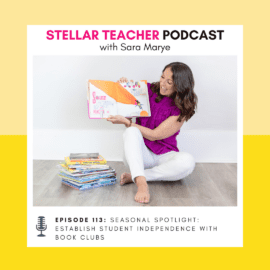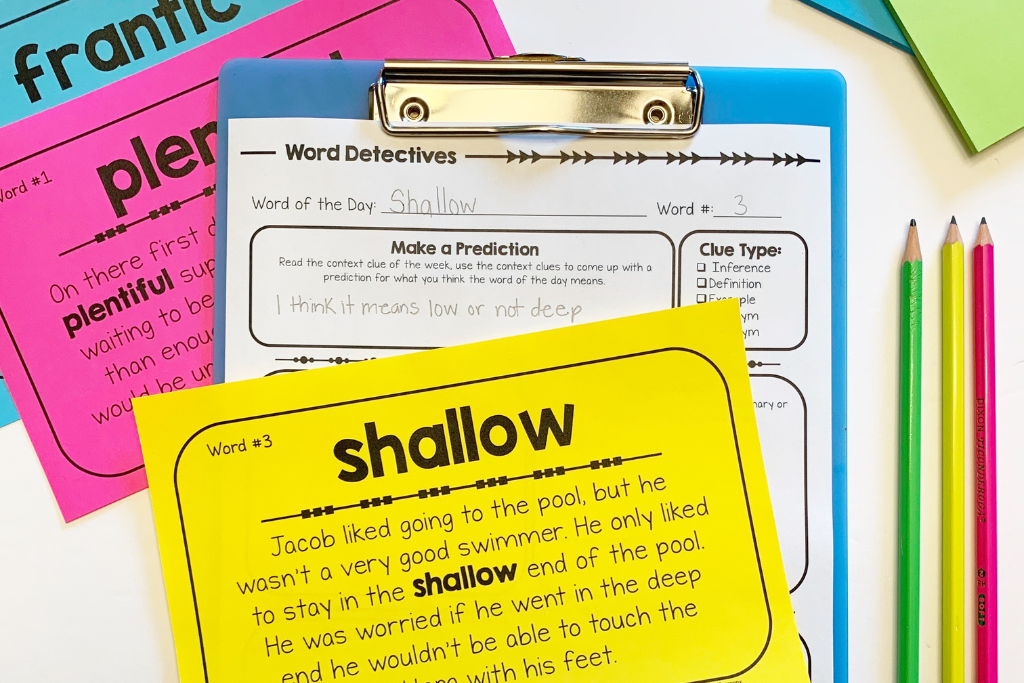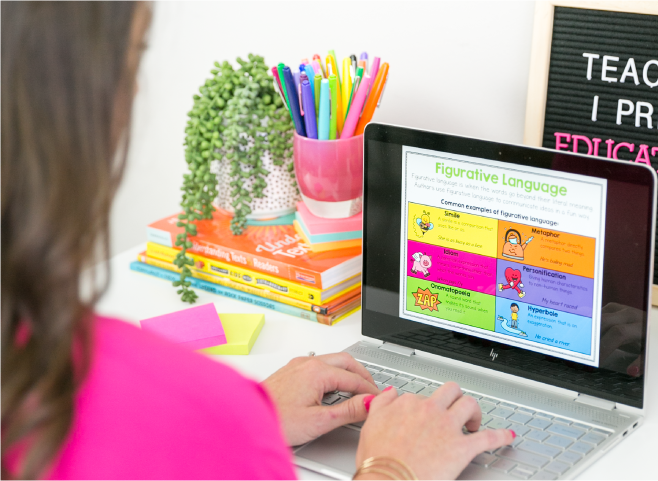
Click play below to listen to a simple, five-day framework you can use to provide intervention to struggling readers in upper elementary.
In this episode of The Stellar Teacher Podcast, I’m sharing a simple, effective five-day routine to help upper elementary students who are struggling with reading. I know how overwhelming it can feel to support students who are behind while still teaching grade-level content, so my goal is to give you a strategy that’s easy to implement and takes just 15 minutes a day. I walk through why intervention is so challenging in upper elementary, and why many traditional resources don’t meet the needs of third-, fourth-, and fifth-grade students who still need phonics, decoding, and phonemic awareness support.
I break down each day of the five-day routine, showing you exactly what to do: from introducing a weekly sound-spelling pattern, practicing phonics with activities like “tap it, map it, graph it,” building fluency through reading words, phrases, and sentences, to applying skills in decodable texts and finishing with spelling and fun games. This routine is structured yet flexible, allowing you to pull small groups, work with your whole class, or adapt it to your schedule. I also share how to make these lessons engaging for upper elementary students so they stay motivated and build confidence with big words and tricky spelling patterns.
Finally, I talk about resources and tools that make this routine even easier, including the Stellar Reading Intervention Toolkit. This ready-to-use toolkit follows the five-day framework and includes everything you need—word lists, activities, decodable texts, comprehension questions, and follow-ups—so you can start teaching right away without the stress of planning from scratch. I challenge you to pick one sound-spelling pattern this week and give the routine a try. Even small steps can make a huge difference in helping your students catch up, gain confidence, and become successful readers.
In this episode on providing intervention for struggling readers, I share:
- How to implement a simple, five-day reading intervention routine for upper elementary students
- Strategies to help students decode and read multi-syllabic words with confidence
- Daily activities for building phonemic awareness, phonics skills, fluency, and comprehension
- Ways to use short, focused lessons that take just 15 minutes a day
- Tips for integrating decodable texts, word lists, and games into your intervention routine
- How to make intervention age-appropriate so students feel successful without feeling “babyish”
- Practical advice for getting started immediately, even if you’ve never taught intervention before
Resources:
- Get the Stellar Intervention Toolkit
- Join The Stellar Literacy Collective
- Sign up for my Private Podcast: Confident Writer Systems Series
- Sign up for my FREE Revision Made Easy email series
- If you’re enjoying this podcast, please leave a review on Apple Podcasts!
Related Episodes and Blog Posts:
- Episode 261, Reading Intervention Made Easy: 15-Minute Lessons for Struggling Readers in Upper Elementary
- Episode 260, Dear Stellar Teacher: Our Phonics and Intervention Confessions (and What We’d Do Differently!)
- Blog: Intervention Ideas for Students Who Struggle With Reading
Connect with me:
- Join my newsletter
- Shop my TPT store here
- Subscribe to our YouTube channel
- Instagram: @thestellarteachercompany
- Facebook: The Stellar Teacher Company
More About Stellar Teacher Podcast:
Welcome to the Stellar Teacher Podcast! We believe teaching literacy is a skill. It takes a lot of time, practice, and effort to be good at it. This podcast will show you how to level up your literacy instruction and make a massive impact on your students, all while having a little fun!
Your host, Sara Marye, is a literacy specialist passionate about helping elementary teachers around the world pass on their love of reading to their students. She has over a decade of experience working as a classroom teacher and school administrator. Sara has made it her mission to create high-quality, no-fluff resources and lesson ideas that are both meaningful and engaging for young readers.
Each week, Sara and her guests will share their knowledge, tips, and tricks so that you can feel confident in your ability to transform your students into life-long readers.
Tune in on your favorite podcast platform: Apple, Google, Amazon, Spotify, Castbox, and more! If you’re loving this podcast, please rate, review, and follow!
Podcast (stellar-teacher-podcast): Play in new window | Download
Hey there, stellar teachers. Welcome back to another episode of the Stellar Teacher Podcast. I’m your host, Sara Marye, and today we’re going to talk about a topic that I think you can really connect with. Let me know if you’ve ever felt overwhelmed by trying to figure out how to support your struggling readers while also keeping up with grade-level standards. If that’s something that has overwhelmed you in the past, today’s episode is for you. We’re going to talk all about providing intervention—specifically, a five-day routine that works for upper elementary students and for busy teachers like you. I know you have a lot on your plate. I know teachers often feel like they don’t have time to do one more thing, but I just want to remind you—and hopefully, by the end of this episode, you’ll realize—that you can help your students who are behind in reading, even if you only have 15 minutes a day. So let’s go ahead and jump right in.
First of all, let’s talk a little bit about why upper elementary intervention is so challenging. If you are an upper elementary teacher, you probably already know that providing intervention to our third-, fourth-, and fifth-grade students can feel like an impossible challenge. For starters, many of our students missed key foundational skills in the earlier grades, and now that they’re in third, fourth, and fifth, they are expected to read and comprehend grade-level texts without the tools they need to do so.
There’s this common saying: in kindergarten, first, and second, students are learning to read, and then in third, fourth, and fifth, they’re reading to learn. But what happens when a student still doesn’t know how to read in third, fourth, or fifth grade? If they don’t have those foundational skills, they’re going to struggle. And oftentimes, our grade-level content does not provide the time, materials, or support to go back and rebuild or reinforce that foundation.
Another challenge is that many intervention resources are really only designed for K–2, and that’s because phonics is a huge priority in the early elementary grades. We don’t see a ton of materials, resources, or support for third-, fourth-, and fifth-grade teachers. Maybe you’ve experienced this. I remember being a fourth-grade teacher with students who did not know how to read. I thought, “Okay, I’m going to help them,” but then I had to find decodable text. The problem was, this decodable text was written for a kindergartner—it was way too basic, babyish, and didn’t align with the needs of my fourth-grade students. So even though I had fourth graders who needed help with phonics and decoding, they didn’t have access to materials that would actually help them. Finding materials alone can feel so challenging.
And then, of course, there’s the time issue. You have whole-group lessons, small-group lessons, grading, planning, parent emails, assemblies—all of those things. A lot of times, intervention gets overlooked or passed over. I don’t think that’s necessarily intentional. I know all teachers really want their students to be successful readers and want to prioritize it, but upper elementary teachers often feel uncomfortable or lack confidence in their ability to effectively teach phonics. Maybe you are one of those teachers, thinking, “Okay, I want to help, but where do I even start? I have no training in phonics. Which phonics skills should I teach? How long should I teach them? How do I know if these interventions are working?”
If you’ve ever asked yourself those questions, take a deep breath. The reality—and the good news—is that providing intervention doesn’t have to be complicated or overwhelming. One thing that can be really helpful, and what we’re going to talk about next, is having a really clear, consistent framework. If you know exactly what to do with your students every single day—something you can rinse and repeat week after week—it eliminates overwhelm and confusion. It can easily become a plug-and-play framework where all you have to do is plug in the phonics skills that you’re teaching each week, and you know exactly what to do.
So I’m going to share with you a five-day routine that works for upper elementary students who still need support with phonics, decoding, and phonemic awareness. This weekly routine is designed to take just 15 minutes a day, and yes, you can see significant growth in just 15 minutes a day. The lessons are short, focused, but also flexible enough that you can fit them into your schedule in a variety of ways.
Maybe you have time during your morning meeting or morning arrival when students are trickling in, and you could pull a small group. Maybe you have time during your literacy block while the rest of your students are in centers or reading independently, and you could pull a group then. You could also use this framework with a whole group. Maybe you have a large group of students in your class that are still struggling with phonics skills and would benefit from this routine—you could do this whole group as well.
Here’s what it looks like. Every day, you’re going to do something different with your weekly focus pattern. Every week, you’ll focus on one specific sound-spelling pattern, and each day, you’ll do something different with it. Before you jump into your daily activity, spend one to two minutes doing a phonemic awareness warm-up. You might do something like phoneme segmentation, blending, or sound manipulation. These activities help students learn to hear, isolate, and manipulate individual sounds. Students need strong phonemic awareness if we want them to be strong readers and spellers, and this is often an area that students lack. So every day, we do a little phonemic awareness with words that include our sound-spelling pattern for the week. That’s a given.
On Day One of the week, you’ll introduce the sound-spelling pattern. Start by explicitly teaching whatever pattern you’re focusing on. Maybe you’re teaching the VCe spelling of a long vowel sound. Maybe it’s an r-controlled vowel like -or. Maybe it’s a diphthong like -oi/oy. Pick your target sound-spelling pattern and introduce it. Be really explicit.
It can be helpful to have an anchor chart that clearly explains and defines the rules of the pattern. For example, if you’re introducing the diphthong -oi/oy, make sure students understand that if they hear -oi at the end of a word, it’s usually spelled -oy, and if they hear -oi in the middle of a word, it’s usually spelled -oi. Having that knowledge makes it easier for students to figure out the sounds in the words they see. In upper elementary, it’s important not to expose students only to single-syllable words. Show them examples in multisyllabic words as well. This is often a big challenge in upper elementary—students see many big words, and we often fail to point out spelling-pattern examples in those words. So give students examples of big words from the beginning, and revisit your anchor chart daily to remind them of the specific sound. Day One is all about introducing the sound-spelling pattern.
On Day Two, you’ll give your students a specific phonics activity to give them the opportunity to sort or write words that follow the target pattern for the week. Students need to see a lot of examples so they start to recognize the pattern automatically. You can use magnetic letters, whiteboards, word cards—whatever materials you have available. One of my favorite phonics activities is called “Tap It, Map It, Graph It,” and you don’t need a ton of materials—you just need the words ready to go.
Here’s how it works. You give students a word with the target spelling pattern, and then they repeat it. Let’s say the word is spoil. Students say spoil, then tap out the sounds using fingers or counters. They tap S-P-OI-L—four sounds. Next, they map it by drawing a line for each sound on paper or a whiteboard—four lines in this case. Finally, they graph it by writing the letter or letter combination they hear for each sound on the line: S on the first line, P on the second line, OI on the third line (because that letter combination makes the OI sound), and L on the last line.
And this is really helpful because a lot of times students either forget or don’t remember that sometimes letter combinations make a single sound. So when they write OI on that one line, it helps solidify that the combination makes the OI sound. This tap-it, map-it, graph-it activity really helps students with orthographic mapping, which is essential for automatic word recognition. That’s how we make these sound-spelling patterns automatic in the brain. So tap it, map it, graph it is a great activity to do with your students on Day Two.
On Day Three, our students have an understanding of the sound-spelling pattern and have done some isolated phonics practice with it. Now we start to layer in fluency. Students read words, then phrases, then full sentences that include the sound-spelling pattern. This helps build confidence, automaticity, and gets them used to seeing the pattern in context. You could have them do this with partner practice or individually, giving them a list of five, ten, or fifteen words—whatever fits your time and capacity. This also helps students recognize that they can read words with the pattern and reinforces their understanding.
On Day Four, you give students an opportunity to apply everything they’ve been working on by reading a short decodable text. Find a text with lots of words containing your target spelling pattern. Even though our intervention lessons focus on word recognition, we don’t want to forget the main purpose of reading, which is comprehension. In addition to reading the decodable text for pattern practice, ask comprehension questions, provide written responses, or have a discussion about the text. This ensures students understand what they are reading. On this day, the goal is to move students from seeing the target spelling pattern in isolation to seeing it in real reading experiences.
Finally, on Day Five, we focus on encoding, or spelling, often using a game. You can give students a mini spelling test or dictation sentences for encoding practice. The goal is not to trick students—don’t give overly challenging words. You simply want to see if they can spell words with the target pattern correctly. This helps you assess whether they have mastered the pattern for the week.
It’s also important to make this fun. Upper elementary students—third, fourth, and fifth graders—often know they struggle with reading, so we want this to be engaging and enjoyable so they want to continue the routine week after week. Finish with a game like Bingo, Memory Match, Go Fish—anything that reinforces words with the target spelling pattern and is enjoyable for students.
Ultimately, this framework works because it’s consistent—you and your students know what to expect each day. It’s comprehensive, covering phonemic awareness, phonics, fluency, and comprehension, addressing all aspects of the reading foundation. Most importantly, it moves students from rule introduction to applying the sound-spelling pattern in both reading and writing.
Okay, so many of you are probably thinking, “Okay, this routine actually sounds doable, and it sounds like something I could handle on a weekly basis.” But you might also be wondering, “I understand the routine and how it works, but where do I find the materials for this routine?” You can totally piece this together on your own. You can do an internet search or check what your school already has to find a phonics scope and sequence, word lists, decodable texts, games—whatever you need. This routine can work with any resources you have available.
But maybe you’re thinking, “That sounds like a lot of work. I want something that’s done-for-you, ready to print, let me just start teaching.” If that’s you, let me briefly tell you about our Stellar Reading Intervention Toolkit. We just released it this summer, and I absolutely love it. I’ve been wanting to create this for a long time because it’s the exact resource I needed when I was a fourth-grade teacher. I needed grade-level appropriate materials that would help my students decode while teaching key phonics skills.
Our toolkit follows the exact five-day routine I described in this podcast. It’s completely ready to use. There are nine different units covering a variety of sound-spelling patterns, with a strong focus on vowels. In upper elementary, vowels often trip students up—there are so many long vowel spelling patterns to understand, including frequency, position in the word, and exceptions. So we put a lot of emphasis on that.
You don’t have the luxury of going as slow with phonics instruction as you would in kindergarten, first, or second grade, so it’s essential to focus on what will make the biggest difference. Vowels are key. Altogether, there are 51 weeks of lessons in this toolkit. Everything you need is included: word lists, phonics activities, games, decodable texts, comprehension questions, and follow-up activities. It’s all ready to print. My favorite part is that the materials are age-appropriate. A fourth grader might not even realize they are doing intervention—they just think they’re reading. Best of all, this is designed to take just 15 minutes a day. There’s no guesswork, no babyish materials—just everything you need to help your students catch up and feel confident about reading. If this sounds like something that could help you, go to stellarteacher.com/intervention.
Now, here’s your challenge for the week: pick one sound-spelling pattern that your students need help with and try out this five-day routine. It doesn’t have to be perfect—you just have to get started. Even if all you do is introduce “tap it, map it, graph it” to your students, you’ve made progress. So many upper elementary teachers put off helping their struggling readers because they don’t know where to start, feel they lack confidence, or haven’t had training in phonics. I get it—I’ve been there. But here’s the truth: the only way to gain confidence is to start. You absolutely can help your struggling readers catch up and become confident, successful readers.
Remember, intervention doesn’t have to be overwhelming. With a simple, consistent routine, you can show up confidently for your students, and over time, all of those small actions add up to make a huge difference. Thank you so much for tuning in today. If you found this episode helpful, share it with a teacher friend who could use support with intervention, and I’ll see you back here next Monday.








Leave a Comment
You must be logged in to post a comment.